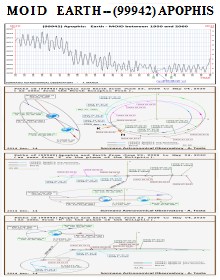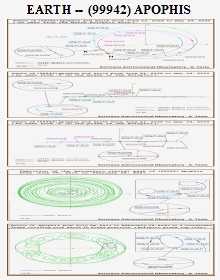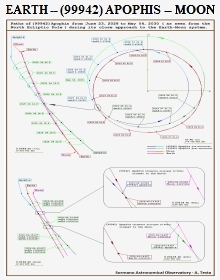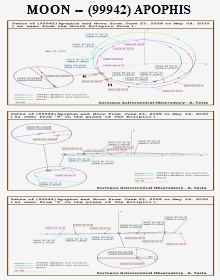![[oas]](logo2.gif) |
OAS - Osservatorio Astronomico Sormano |
| OAS > Asteroid (99942) Apophis |
![[oas]](logo2.gif) |
OAS - Osservatorio Astronomico Sormano |
| OAS > Asteroid (99942) Apophis |
Last update: March 27, 2021
Computations: Francesco Manca, Piero Sicoli, Augusto Testa (obs.sormano@alice.it).
|
(99942) Apophis, Greek name of Apep - the Egyptian god of evil and destruction,
was discovered by R.A Tucker, D.J. Tholen and F. Bernardi on June 19, 2004 at
Kitt Peak (code 695).
Observed only two nights it was rediscovered on December 18, 2004 at
Siding Spring Survey (code E12).
Here are available AVI(about 4 Mb) or GIF (about 1 Mb) animation of n.6 CCD images taken at Sormano (Italy) on December 30, 2004 when the object was just 14 degrees above the local horizon. Herschel Space Observatory made the first thermal infrared observations of this asteroid returning a more precise diameter of 325+/-15m. Using recent observations, NASA scientists reduce the likelihood of an hazardous encounter with our planet in 2036 but its follow up is still a priority. (see NASA ruled out Earth impact in 2036 for asteroid Apophis). Investigation to plan a spacecraft rendezvous with this asteroid is under consideration both to perform more accurate study on its chemical composition or to deflect it, if necessary, using a "gravitational tractor". |
The following results were computed at Sormano Observatory on December 2, 2014 using a
software developed at Sormano and OrbFit 5.0.5 (OrbFit Software Package - Univ. of Pisa Italy),
and are based on 13 radar delay, 7 Doppler and 4182 optical observations from March 15, 2004 to February 26, 2014.
According to our computations at the date Dec. 2, 2014, Apophis will pass at a nominal distance of 38315 Km (about 32000 Km from Earth's surface)
on April 13, 2029 at 21h 45.1min UT, about 8 minutes before its passage at the
MOID point. (see the below diagrams)
| Date (UT) | Nominal Distance (AU) | Min possible distance (AU) | Max possible distance (AU) |
| 2029-04-13.906 | 0.00025612 | 0.00025607 | 0.00025617 |
The following results were computed at Sormano Observatory on March 27, 2021 using a software developed at Sormano and OrbFit 5.0.7 (OrbFit Software Package - Univ. of Pisa Italy), and are based on 50 radar and 7430 optical observations from March 15, 2004 to March 26, 2021.
| Date (UT) | Nominal Distance (AU) | Min possible distance (AU) | Max possible distance (AU) |
| 2029-04-13.907 | 0.00025411 | 0.00025410 | 0.00025412 |
Diagrams of the Minimum Orbital Intersection Distance (MOID ) and Apophis's path in reference to the Earth-Moon system as follows:




For more details see our lists:
TECA - Table of Asteroids Next Closest Approaches to the Earth
TAM - Table of Asteroids Next Closest Approaches to the Moon
MBPL - Minor Body Priority List ( Asteroids with H < = 22.0 )
See the BBC Online article (March 25, 2010) "Cuts cast doubt on asteroid plan"
For more information please see JPL reference:
or
NEODYS summary page:
See also:
![]() Back to Sormano Astronomical Observatory Home Page
Back to Sormano Astronomical Observatory Home Page